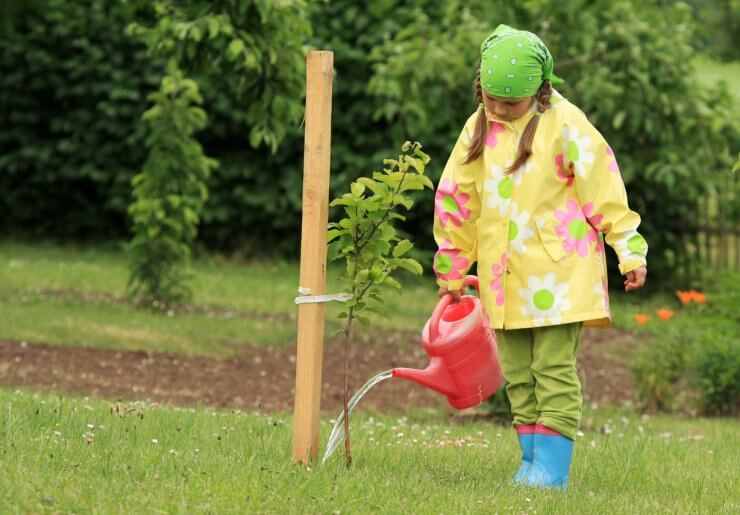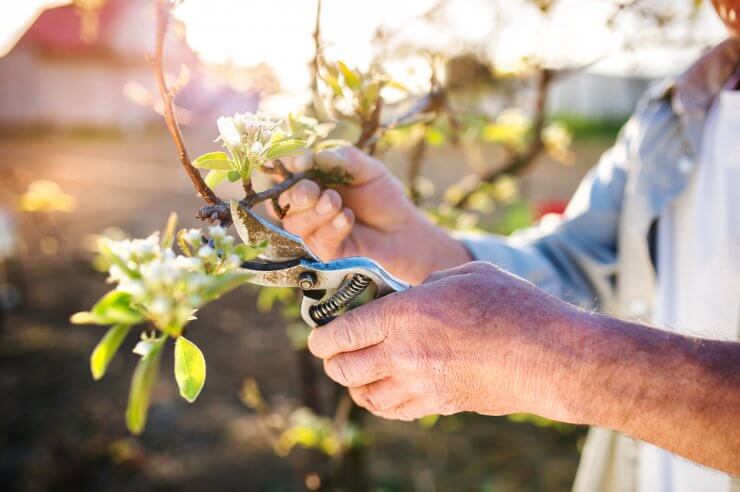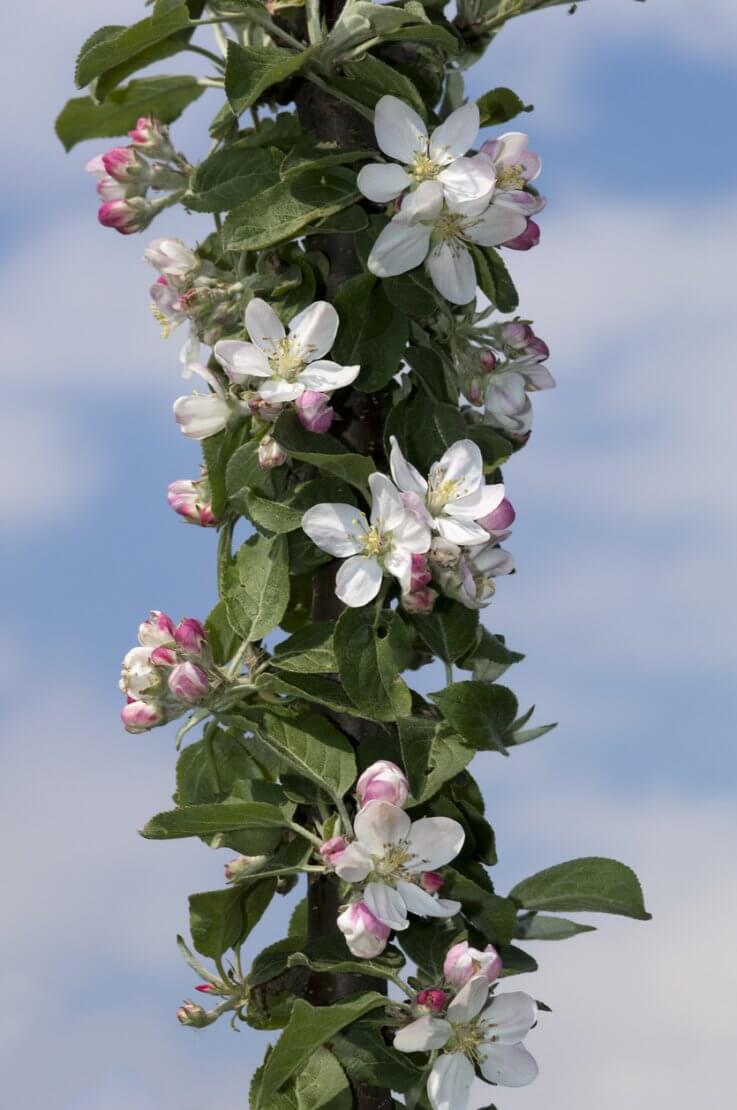
Young gardener watering apple tree
Water
Once your apple trees are settled in—whether it’s in a container, a raised bed, or open ground—consistency is key when it comes to watering. Apple trees like about an inch of water every 10 days or so. How often you need to get out the hose or make a trip to the rain barrel will depend on your local weather.
If the top of the soil is a little dry, that’s OK. But don’t let the soil dry out. This is especially important when you’re tending trees growing in containers—it’s not like they can stretch their roots out in search of more water.
For trees in the ground, a long deep watering is the way to go. To ensure that the tree roots get the thorough watering they need, you can create a watering basin around the drip line of the tree—that’s the perimeter of the canopy where rain would drip off the leaves. Expand your watering basin as the drip line expands.
It’s best to water in the morning, so your tree can soak up that deep drink of water and put it to work growing apples. Of course, if you fall behind in your watering and notice your tree is in serious need of a deep drink, don’t wait until morning. Go get the hose.
Mulch is helpful to help conserve water and deter weeds. Keep all mulch at least 6 inches away from the base of the trunk to avoid root diseases. You can lay down a 2- to 3-inch layer of wood mulch or compost to help with water retention. You can also consider using “living mulch”—nitrogen-fixing clover planted between trees can provide a ready source of nitrogen for your trees while attracting pollinators, or plant some of the plants we mention in Planting Apple Trees in the Ground.
Weeding
When it comes to weeding around your apple trees, early and often is best. If you’ve used weed-free soil, well-rotted organic matter, and laid down mulch, you shouldn’t have a big weed problem.
Properly preparing your soil is an excellent preventive measure against the emergence of weeds. When you till or cultivate the area where you’ll plant your apple tree, remove weeds and debris. You’ll likely find that the first few weeks after planting are the only time you’ll be pulling up weeds around your tree.
If weeds spring up around your apple trees during the growing season, work the soil around the base of the plants with a hoe—only deep enough to kill the weeds and not damage the plant’s roots.
Fertilizer
If your apple trees are planted in nutrient-rich soil, there’s no need to apply fertilizer until your trees start bearing fruit—at roughly the age of two to four years. If your trees don’t produce 8 to 12 inches of new growth during the growing season, plan to apply fertilizer the following spring. Apple trees don’t need fertilizer as they approach their dormant period.
Once your trees start bearing fruit, they’re going to be soaking up more nitrogen. To prepare for that, it’s a good idea to lay down one application of high-nitrogen fertilizer in the spring, once the soil is workable.
Pruning

Gardener pruning apple tree
Do you shudder at the thought of pruning your apple trees? No worries! Pruning is essential to the ongoing health and productivity of your trees. An unpruned apple tree will not grow as well as a pruned tree, and you run the risk of it not producing fruit—and isn’t that why you’re planting an apple tree in the first place?
There are three main reasons for pruning your apple tree: its health, its growth, and its shaping.
Plan to prune your apple trees while they’re dormant. Pruning isn’t difficult, but you want to pay attention to the details as you make your cuts. If you have branches that form very narrow, V-shape angles, you want to remove those limbs. As the tree grows, those limbs could snap off, or worse, split the tree. The branches you want to keep should be growing at approximately the 10 o’clock and 2 o’clock positions.
You want your tree to grow up and out, so look for where the buds are on the branches. Find a bud that’s facing outward; it will likely be on the underside of the branch. Trim at a roughly 45-degree angle, above and parallel to the bud. As you work your way through the tree, you’ll be opening it up to more light and better air circulation.
As you’re pruning, be sure to remove any branches that are weak, diseased, or have too narrow an angle. If branches are crossing or otherwise getting in the way of another branch, remove the weaker of the two branches. If you have branches growing straight up or pointing toward the center of the tree, get out your loppers and cut them off.
Look for the leader branch in the tree—the one growing up the highest from the trunk. Prune that back so it’s about 2 feet higher than the rest of the branches of the tree (called lateral limbs). This will help the tree grow strong.
If you discover dead or damaged limbs, don’t wait until your tree is dormant to get rid of them. Go ahead and prune them right away.
Another reason to prune your apple tree is if you are training it to grow in a particular shape. Dwarf trees are especially good candidates for special pruning to train them to grow along a wall, fence, or trellis.
There are many different shapes into which you can train your apple trees to grow. It requires planning, patience, stakes, ties, and in some cases—toothpicks. Really. Some of the shapes you may choose, depending on your space, include cordon (a single line), double cordon (two lines), and espalier (a spreading shape, sometimes like a fan).

Flowering columnar apple tree
The key thing to note here is that when you train your trees this way, they become more two-dimensional than three-dimensional. You’re training them to grow along a fence or a wall rather than up and out. In the case of a single cordon, you’re limiting the tree to just a single stem. It may be a little odd looking, and you’ll never get the big harvest of a multi-branched tree, but it’s an ideal solution if you have limited space but you still want fresh fruit.
Thinning
Thinning serves several purposes for apple trees: it reduces the risk of limbs breaking; it gives some energy back to the tree so it can produce bigger apples with better flavor; and it can encourage floral development for the next growing season.
You can thin out the fruit as the tree is producing it. In late spring and early summer, a lot of apple trees will drop underripe fruit. This is totally natural; the tree is freeing up resources to produce better apples. If you don’t do a little thinning, you run the risk of your tree fruiting only every other year, or providing a heavy crop one year and a light one the next. Take a little time to do some thinning. It’s good for the tree, and good for your harvest.
The ideal time to thin out your apple trees is within 20 to 40 days of the tree fully blooming. Trim out developing apples so that the remaining apples are 6 to 8 inches apart. On trees where the apples grow in clusters, identify the king bloom (in the middle of the cluster of five flowers or developing apples) and trim off the rest, either by hand or using clean gardening shears. The middle one will develop into the largest fruit.
How often do you fertilize or water your apple trees? How do you prune your apple trees? Do you train them to grow in a particular shape? Do you have any particular challenges growing apple trees? Please tell us your tips for nurturing healthy apple trees.


 Previous
Previous

